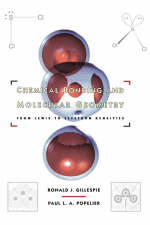
Chemical Bonding and Molecular Geometry
Oxford University Press Inc (Verlag)
978-0-19-510495-0 (ISBN)
- Keine Verlagsinformationen verfügbar
- Artikel merken
Written by one of the world's foremost authorities in the chemical bond, this textbook is ideal for courses on chemical bonding in chemistry departments at the senior/first year graduate level and can also be used to supplement inorganic survey courses needing an increased focus on bonding. The ideal course will contain the word "Bonding" in the course title, e.g. Chemical Bonding. The text starts with the basic principles of bonding and proceeds to advanced level topics in the same volume. It provides undergraduate (and 1st year graduate) students with an introduction to models and theories of chemical bonding and geometry as applied to the molecules of the main group elements. It gives students an understanding of how the concept of the the chemical bond has developed from its earliest days, through Lewis' brillant concept of the electron pair bond, up until the present day. The texts also elucidates the relationships between these various models and theories. Particular emphasis is placed on the valence-shell electron pair (VSEPR) and ligand close packing (LCP) models as well as the analysis of electron density distributions by the atoms in molecules (AIM) theory.
The book is ideal for courses specifically devoted to bindng or to supplement inorganic chemistry courses at both the intermediate and adavanced levels.
Preface
Acknowledgments
Chapter 1 The Chemical Bond: Classical Concepts and Theories
1.1: Introduction
1.2: Valence
1.3: The Periodic Table of the Elements
1.4: Structural Formulas
1.5: Stereochemistry
1.6: The Shell Model
1.7: The Ionic Model of the Chemical Bond
1.8: The Covalent Bond and Lewis Structures
1.9: Polar Bonds and Electronegativty
1.10: Polyatomic Anions and Formal Charges
1.11: Oxidation Number (Oxidation State)
1.12: Donor-Acceptor Bonds
1.13: Exceptions to the Octet Rule: Hypervalent and Hypovalent Molecules
1.14: Limitations of the Lewis Model
Chapter 2 Bond Properties
2.1: Introduction
2.2: Bond Lengths and Covalent Radii
2.3: Multiple Bonds and Bond Order
2.4: Ionic Radii
2.5: The Lengths of Polar Bonds
2.6: Back-Bonding
2.7: Bond Dissociation Energies and Bond Enthalpies
2.8: Force Constants
2.9: Dipole Moments
Chapter 3 Some Basic Concepts of Quantum Mechanics
3.1: Introduction
3.2: Light, Quantization, and Probability
3.3: The Early Quantum Model of the Atom
3.4: The Wave Nature of Matter and the Uncertainty Principle
3.5: The Schrödinger Equation and the Wave Function
3.6: The Meaning of the Wave Function: Probability and Electron Density
3.7: The Hydrogen Atom and Atomic Orbitals
3.8: Electron Spin
3.9: The Pauli Principle
3.10: Multielectron Atoms and Electron Configurations
3.11: Bonding Models
3.12: Ab Initio Calculations
3.13: Postscript
Chapter 4 Molecular Geometry and the VSEPR Model
4.1: Introduction
4.2: The Distribution of Electrons in Valence Shells
4.3: Electron Pair Domains
4.4: Two, Three, Four, and Six Electron Pair Valence Shells
4.5: Multiple Bonds
4.6: Five Electron Pair Valence Shells
4.7: Limitations and Exceptions
Chapter 5 Ligand-Ligand Interactions and the Ligand Close-Packing (LCP) Model
5.1: Introduction
5.2: Ligand-Ligand Interactions
5.3: The Ligand Close-Packing (LCP) Model
5.4: Bond Lengths and Coordination Number
5.5: Molecules with Two or More Different Ligands
5.6: Bond Angles in Molecules with Lone Pairs
5.7: Weakly Electronegative Ligands
5.8: Ligand-Ligand Interactions in Molecules of the Elements in Periods 3-6
5.9: Polyatomic Ligands
5.10: Comparison of the LCP and VSEPR Models
Chapter 6 The AIM Theory and the Analysis of the Electron Density
6.1: Introduction
6.2: The Hellmann-Feynman Theorem
6.3: Representing the Electron Density
6.4: The Density Difference or Deformation Function
6.5: The Electron Density from Experiment
6.6: The Topology of the Electron Density
6.7: Atomic Properties
6.8: Bond Properties
6.9: The Diatomic Hydrides of Periods 2 and 3
6.10: Summary
Chapter 7 The Laplacian of the Electron Density
7.1: Introduction
7.2: The Laplacian of the Electron Density
7.3: The Valence Shell Charge Concentration
7.4: The Laplacian and the VSEPR Model
7.5: Electron Pair Localization and the Lewis and VSEPR Models
7.6: Summary
Chapter 8 Molecules of the Elements of Period 2
8.1: Introduction
8.2: The Relationship between Bond Properties and the AIM Theory
8.3: The Nature of the Bonding in the Fluorides, Chlorides, and Hydrides of Li, Be, B, and C
8.4: The Geometry of the Molecules of Be, B, and C
8.5: Hydroxo and Related Molecules of Be, B, and C
8.6: The Nature of the CO and Other Polar Multiple Bonds
8.7: Bonding and Geometry of the Molecules of Nitrogen
8.8: The Geometry of the Molecules of Oxygen
8.9: The Geometry of the Molecules of Fluorine
Chapter 9 Molecules of the Elements of Periods 3-6
9.1: Introduction
9.2: Hypervalence
9.3: Bonding in the Fluorides, Chlorides, and Hydrides with an LLP Coordination Number Up to Four
9.4: Geometry of the Fluorides, Chlorides, and Hydrides with an LLP Coordination Number Up to Four
9.5: Molecules with an LLP Coordination Number of Five
9.6: Molecules with an LLP Coordination Number of Six
9.7: Molecules with an LLP Coordination Number of Seven or Higher
9.8: Molecules of the Transition Metals
Index
Formula Index
| Erscheint lt. Verlag | 1.4.2001 |
|---|---|
| Zusatzinfo | 15 halftones, 203 line figures |
| Verlagsort | New York |
| Sprache | englisch |
| Gewicht | 583 g |
| Themenwelt | Naturwissenschaften ► Chemie ► Anorganische Chemie |
| Naturwissenschaften ► Chemie ► Physikalische Chemie | |
| ISBN-10 | 0-19-510495-1 / 0195104951 |
| ISBN-13 | 978-0-19-510495-0 / 9780195104950 |
| Zustand | Neuware |
| Haben Sie eine Frage zum Produkt? |
aus dem Bereich


